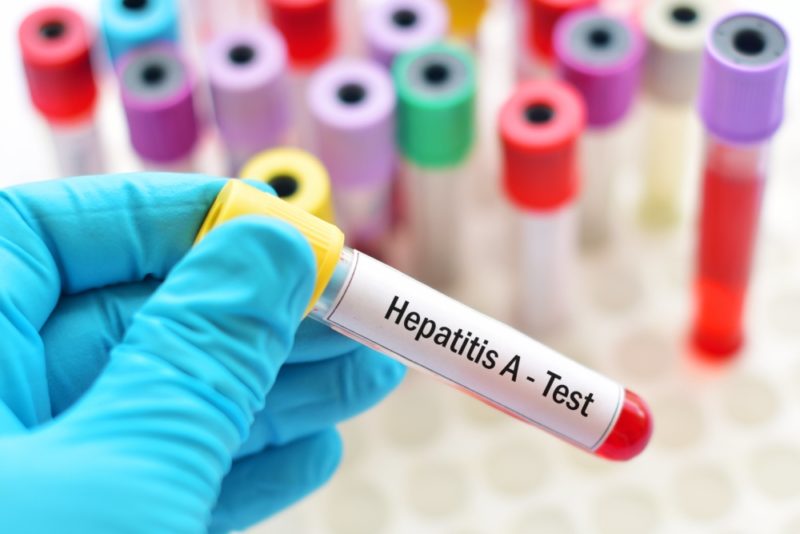One of the most common liver diseases is hepatitis. To date, several varieties of this pathology are distinguished. What are the main symptoms of hepatitis A and what is the treatment of the disease, read below.
Material Content:
General characteristics of hepatitis A
Hepatitis A, also called Botkin's disease, is a liver disease caused by the hepatitis A virus.
Hepatitis A virus is extremely survivable. So, when boiling, its death occurs only after 5 minutes. Being in a solution of chlorine, the pathogen dies only after half an hour. In an acidic environment and in a 20% solution of ethyl alcohol, the virus is not inactivated at all, and in water at a temperature of about 20 C it can survive 3 days.
The disease is considered quite dangerous and can lead to a series of social and economic consequences. Ill people may need weeks and months to return to a full life.
Forms and stages of the virus
Viral hepatitis is expressed in 3 forms:
- spicy;
- lightning fast;
- chronic
Getting into the body of an infected person, the virus provokes the development of the acute stage of hepatitis A. Pathology gradually flows into a chronic form if the human immune system could not cope with the causative agent of the disease.
The fulminant form is extremely dangerous, since it entails acute liver failure, which can end tragically. At the same time, the signs of intoxication are growing much faster than in the acute form, a person is able to "fade away" in just a few days.
Note.Hepatitis A can occur in an anicteric or icteric form. In the first case, pathology is more difficult to differentiate, since the main symptom of the disease is absent, and hepatitis is easily confused with other ailments. An anicteric form of the disease is typical for children under 6 years of age (almost 90% of cases). In adult patients, this form is monitored in 30% of cases.
The acute form of the disease is marked by the following stages of pathogen activity:
- The causative agent enters the body from the environment.
- It enters the liver using blood flow and lymph flow.
- Passes the membrane barrier of the liver.
- Passes its code to the cellular genome.
- Hepatocytes (liver cells) clone the virus, creating copies of it.
- Under the influence of viruses, hepatocytes begin to die in large numbers.
- Symptoms of impaired liver function appear.
Further, events can develop in two scenarios. With a favorable prognosis, the body's immunity destroys the virus that has penetrated the cells, and the patient recovers. Another option - the human immune system blocks the mass reproduction of the causative agents of the disease, but some of them are delayed in the body. In this case, the pathology flows into the chronic stage, complicating the process of diagnosis and subsequent therapy.
How is the disease transmitted?
Sick people are considered sources of hepatitis A virus, and the cause of the disease is the penetration of the pathogen into the body. Absolutely any apparently healthy person is able to get infected who has not noticed the manifestations of hepatitis A before and has not been vaccinated against it.
Often the virus spreads orally-fecal, that is, when eating food or water contaminated with secretions from an already infected person. However, water does not have to be used for drinking. You can also get infected after swimming in contaminated lakes, while brushing your teeth, washing your hands or dishes. Often people who take drugs are affected. Weakened immunity also increases the risk of hepatic pathology.
The first signs in children and adults
The incubation period of the disease is 8-50 days (an average of 14-28). At this time, the patient is already considered contagious and dangerous to those around him. At the same time, the first signs of hepatitis A are not yet observed in him.
Note. Acute hepatitis in some cases resembles influenza and acute respiratory infections, the main symptoms of which are muscle and headache, hyperthermia.
Symptoms of Hepatitis A
The main symptoms of hepatitis A in children and adults are:
- jaundice of the skin, mucous membranes;
- depressive state;
- sleep disturbance;
- hyperthermia;
- pain in the right hypochondrium;
- dark urine
- general malaise;
- nausea, vomiting;
- enlarged liver, spleen;
- headache;
- light shade of feces.
Symptoms of a chronic form are not tracked too clearly. Patients often do not even suspect hepatitis A at all, attributing all the ailments and discomfort to overwork or other diseases. Symptoms become apparent only when the disease flows into the final stage.
Diagnostic measures
In the process of diagnosis, it is very important to differentiate hepatitis A with other diseases that are similar in symptoms. Although many typical symptoms indicate hepatitis, just examining and interviewing the patient to establish a diagnosis is not enough.
For a more accurate diagnosis, the following research methods are used:
- blood test for antibodies;
- general and biochemical blood analysis;
- X-ray, ultrasound, MRI.
With hepatitis A, a blood test will show a high number of liver enzymes, which indicates pathological processes that occur in the liver. Hepatitis is also characterized by an increase in white blood cells and ESR. CTG and ultrasound will help to more closely monitor the condition of the liver and the internal organs closest to it.
How to treat hepatitis A
To date, there is no specific treatment for hepatitis A in medicine.
Basic therapy involves eliminating the effects of liver damage.
The list of therapeutic measures includes:
- Maintaining a healthy lifestyle.
- Refusal of hepatotoxic drugs.
- Compliance with a special diet.
Drug treatment consists of the use of hepatoprotectors (Pancreatin, Smecta, Essential Forte, Festal, Carsil, etc.). In case of impaired bowel function, eubiotics may be prescribed. Additionally, you can take medicinal herbs with weak antiviral activity (licorice, celandine, St. John's wort).
Therapeutic diet
An important element of hepatitis A therapy is adherence to dietary principles. With this disease, nutrition should correspond to the diet "Table 5" according to Pevzner.
A general characteristic of such a scheme is contained in the following daily indicators:
- proteins - 90-100 g;
- fats - 80-100 g;
- carbohydrates - 350-400 g.
The list of allowed products includes:
- vegetables;
- dairy products;
- fruits;
- chocolate;
- cereals;
- lean meat, fish;
- greenery.
A number of products are best excluded from the menu:
- canned food, marinades;
- mushrooms;
- coffee;
- oily fish and meat;
- baking;
- spicy, fried, salty dishes;
- carbonated drinks;
- fresh bread.
Food should be fractional (5-6 times a day). Each meal includes small portions.
Vaccination against illness
Hepatitis A vaccine is the main way to prevent the disease. The vaccine contains neutralized hepatitis viruses. It is characteristic that immunity after vaccination does not develop instantly, but only after 3-4 weeks. In order to enhance the effect, re-vaccination is recommended six months after the first. But even two vaccinations do not guarantee lifelong immunity from hepatitis A. According to the observations of doctors, the effect of the vaccine given lasts about 8 years.
Note. Some categories of citizens must be vaccinated against hepatitis A. These include the military, cooks, doctors, etc. As well, vaccination is recommended for people planning a trip to countries with a hot climate in the near future.
Preventive measures
Prevention measures for hepatitis A are quite simple and are as follows:
- refusal to use unboiled water (including for washing dishes, brushing teeth, etc.);
- systematic washing of hands, in particular, after visiting the toilet;
- thorough washing of fruits and vegetables (best under running hot water).
At the regional level, disease prevention is carried out by cleaning local reservoirs intended for the needs of residents, introducing quarantine and mass vaccination against this type of hepatitis.
Family members of a person with hepatitis A should be as careful as possible in the process of interacting with him, trying to avoid infection. For this, the patient must be placed in a separate room. Before sending the patient’s laundry for washing, it should be disinfected by boiling for 15 minutes. The dishes from which the patient took food are boiled in a soda solution (2%) for 15 minutes. The same solution is used to handle door handles and other surfaces of the room in which the patient is located.
Tip. Tourists visiting the southern countries and trying local exotic dishes should be especially careful. So, the causative agent of hepatitis A can be transmitted from mollusks from infected waters. Travelers should clearly remember the rule: do not eat food that has not undergone proper heat treatment. If there is no access to clean water, the liquid extracted from potentially unsafe sources should be boiled for at least 10 minutes.
Hepatitis A is one of the varieties of liver diseases that can develop at lightning speed, and therefore is considered extremely dangerous to humans. The complexity of the treatment of this ailment is that there is no specific treatment for Botkin's disease today.Preventive measures and timely diagnosis of the condition of the body will help reduce the risk of the disease in people of different age groups.



















